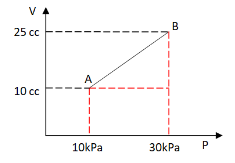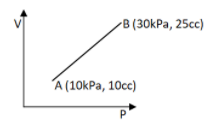
Answer
394.8k+ views
Hint: The work done of the process is found by calculating the area under the curve. Redraw the diagram and extend lines to the X and Y axis from points A and B. Calculate the total area by dividing it into smaller areas. In this figure divide it into a triangular and rectangular area and then sum the values of the area. The total area will give the work done.
Formula used: \[Area{\text{ }}of{\text{ }}rectangle = {\text{ }}length{\text{ }}x{\text{ }}breadth\] ; \[Area{\text{ }}of{\text{ }}triangle{\text{ }} = \;\dfrac{1}{2}*{\text{ }}Base{\text{ * }}height\]
Complete step-by-step solution:

\[P - {\text{ }}Pressure\]
\[Pa - {\text{ }}Pascal{\text{ }}(Unit{\text{ }}of{\text{ }}pressure)\]
\[V - {\text{ }}Volume\]
\[cc - {\text{ }}cubic{\text{ }}centimeter{\text{ }}\left( {Unit{\text{ }}of{\text{ }}volume} \right)\]
The work done is calculated by summing the area under the line AB. So from the diagram, the sum of the area (area 0f the rectangle + area of the triangle) will give the work done for the process.
Given: Initial volume =\[10{\text{ }}cc\] ; Final volume = \[25{\text{ }}cc\]
Initial Pressure =\[10kPa\] ; Final pressure = \[30kPa\]
To find: work done
Area of the rectangle (from the diagram) = Length x breadth
Substituting the values, = \[\left( {30 - 10} \right){\text{* }}10\]
\[ = {\text{ }}20{\text{ * }}10\]
\[Area{\text{ }}of{\text{ }}rectangle\;\;\; = {\text{ }}200kPa.cc\]
Area of the triangle (from the diagram) = \[\;\dfrac{1}{2}{\text{* }}Base{\text{ * }}height\]
\[ = \;\dfrac{1}{2}*{\text{ }}10{\text{ * }}20\]
Simplifying, Area of triangle= \[100\] kPa.cc
The work done is the sum of the area,
Therefore, Work done= Area of rectangle + Area of triangle
Substituting the values, = \[200\] kPa.cc + \[100\] kPa.cc
Adding,= \[300\] kPa.cc
To convert cubic centimeter to cubic meter, multiply by \[{10^{ - 6}}\] (1 cubic centimeter= \[{10^{ - 6}}\] cubic meter)
Therefore, Work done = \[300{\text{ * }}{10^{ - 6}}\] kPa.m3
Since \[kPa = {\text{ }}1000\] Pa and multiplying, Work done= \[0.3\] Pa.m3
Since\[Pa.{m^3} = {\text{ }}J\] , Work done=\[0.3\]J (J- Joules)
Hence option (D) W= \[0.3\]J is the right answer.
Note: The energy that is utilized to move an object against force is called work. The work done by a gas depends on both the initial and final state of a gas. For a pressure-volume graph, the area under the curve gives the work done by the gas.
Formula used: \[Area{\text{ }}of{\text{ }}rectangle = {\text{ }}length{\text{ }}x{\text{ }}breadth\] ; \[Area{\text{ }}of{\text{ }}triangle{\text{ }} = \;\dfrac{1}{2}*{\text{ }}Base{\text{ * }}height\]
Complete step-by-step solution:

\[P - {\text{ }}Pressure\]
\[Pa - {\text{ }}Pascal{\text{ }}(Unit{\text{ }}of{\text{ }}pressure)\]
\[V - {\text{ }}Volume\]
\[cc - {\text{ }}cubic{\text{ }}centimeter{\text{ }}\left( {Unit{\text{ }}of{\text{ }}volume} \right)\]
The work done is calculated by summing the area under the line AB. So from the diagram, the sum of the area (area 0f the rectangle + area of the triangle) will give the work done for the process.
Given: Initial volume =\[10{\text{ }}cc\] ; Final volume = \[25{\text{ }}cc\]
Initial Pressure =\[10kPa\] ; Final pressure = \[30kPa\]
To find: work done
Area of the rectangle (from the diagram) = Length x breadth
Substituting the values, = \[\left( {30 - 10} \right){\text{* }}10\]
\[ = {\text{ }}20{\text{ * }}10\]
\[Area{\text{ }}of{\text{ }}rectangle\;\;\; = {\text{ }}200kPa.cc\]
Area of the triangle (from the diagram) = \[\;\dfrac{1}{2}{\text{* }}Base{\text{ * }}height\]
\[ = \;\dfrac{1}{2}*{\text{ }}10{\text{ * }}20\]
Simplifying, Area of triangle= \[100\] kPa.cc
The work done is the sum of the area,
Therefore, Work done= Area of rectangle + Area of triangle
Substituting the values, = \[200\] kPa.cc + \[100\] kPa.cc
Adding,= \[300\] kPa.cc
To convert cubic centimeter to cubic meter, multiply by \[{10^{ - 6}}\] (1 cubic centimeter= \[{10^{ - 6}}\] cubic meter)
Therefore, Work done = \[300{\text{ * }}{10^{ - 6}}\] kPa.m3
Since \[kPa = {\text{ }}1000\] Pa and multiplying, Work done= \[0.3\] Pa.m3
Since\[Pa.{m^3} = {\text{ }}J\] , Work done=\[0.3\]J (J- Joules)
Hence option (D) W= \[0.3\]J is the right answer.
Note: The energy that is utilized to move an object against force is called work. The work done by a gas depends on both the initial and final state of a gas. For a pressure-volume graph, the area under the curve gives the work done by the gas.
Recently Updated Pages
Fill in the blanks with suitable prepositions Break class 10 english CBSE

Fill in the blanks with suitable articles Tribune is class 10 english CBSE

Rearrange the following words and phrases to form a class 10 english CBSE

Select the opposite of the given word Permit aGive class 10 english CBSE

Fill in the blank with the most appropriate option class 10 english CBSE

Some places have oneline notices Which option is a class 10 english CBSE

Trending doubts
Fill the blanks with the suitable prepositions 1 The class 9 english CBSE

How do you graph the function fx 4x class 9 maths CBSE

When was Karauli Praja Mandal established 11934 21936 class 10 social science CBSE

Which are the Top 10 Largest Countries of the World?

What is the definite integral of zero a constant b class 12 maths CBSE

Why is steel more elastic than rubber class 11 physics CBSE

Distinguish between the following Ferrous and nonferrous class 9 social science CBSE

The Equation xxx + 2 is Satisfied when x is Equal to Class 10 Maths

Differentiate between homogeneous and heterogeneous class 12 chemistry CBSE





